

Explore the history, culture, people and beautiful landscapes of Vietnam on the 63Stravel travel app
Download the 63stravel app

With the advantage of having a total water surface area of over 8,800 hectares, Hoa Binh Lake is not only a place to raise fish in cages bringing economic benefits to more than 2,000 households, but also a place for tourism development of the province.
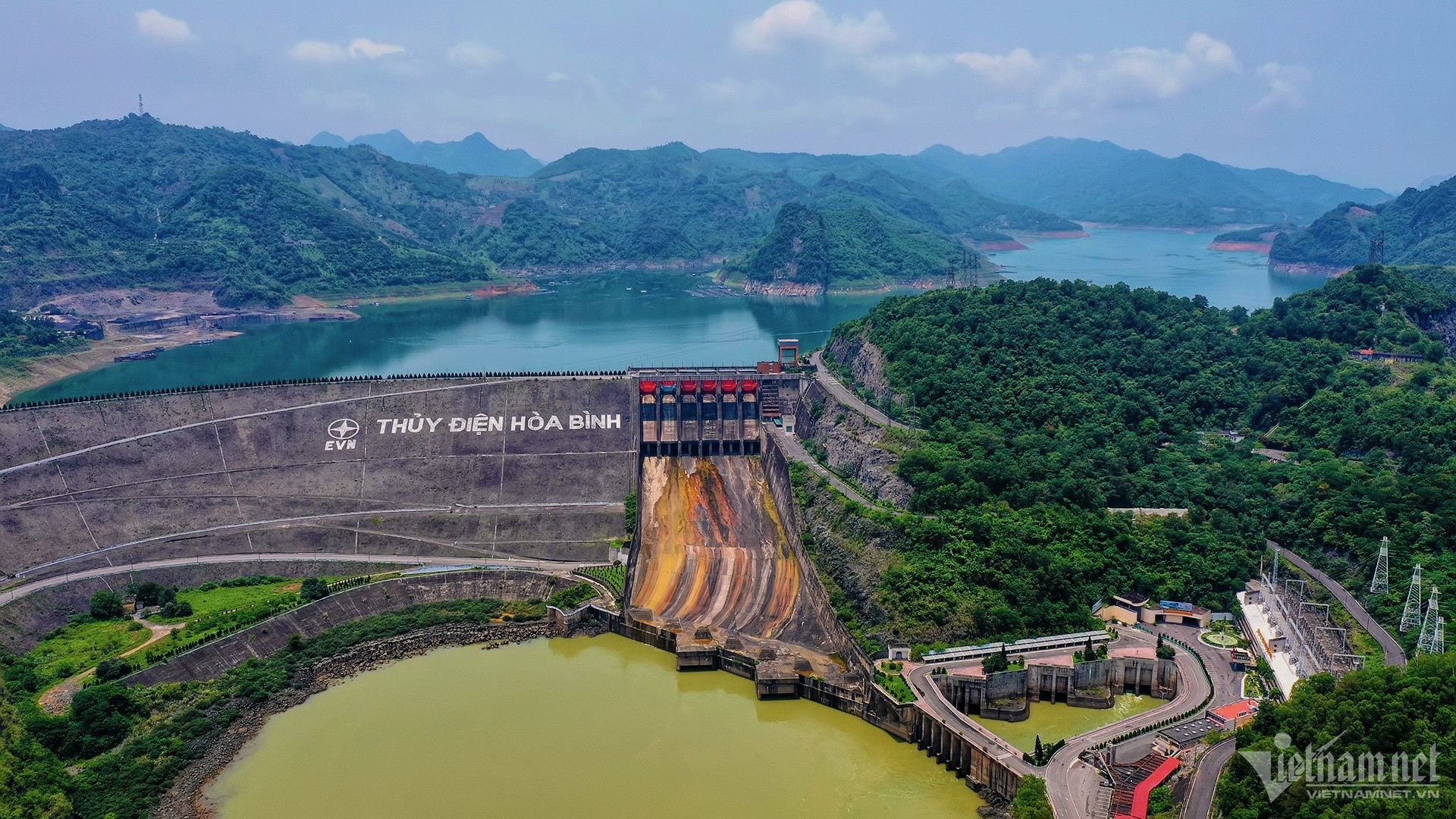
For decades, blocking the Da River to build Hoa Binh Hydropower Plant (from 1979 to 1991) has created a large lakebed area, majestic mountains and rivers.
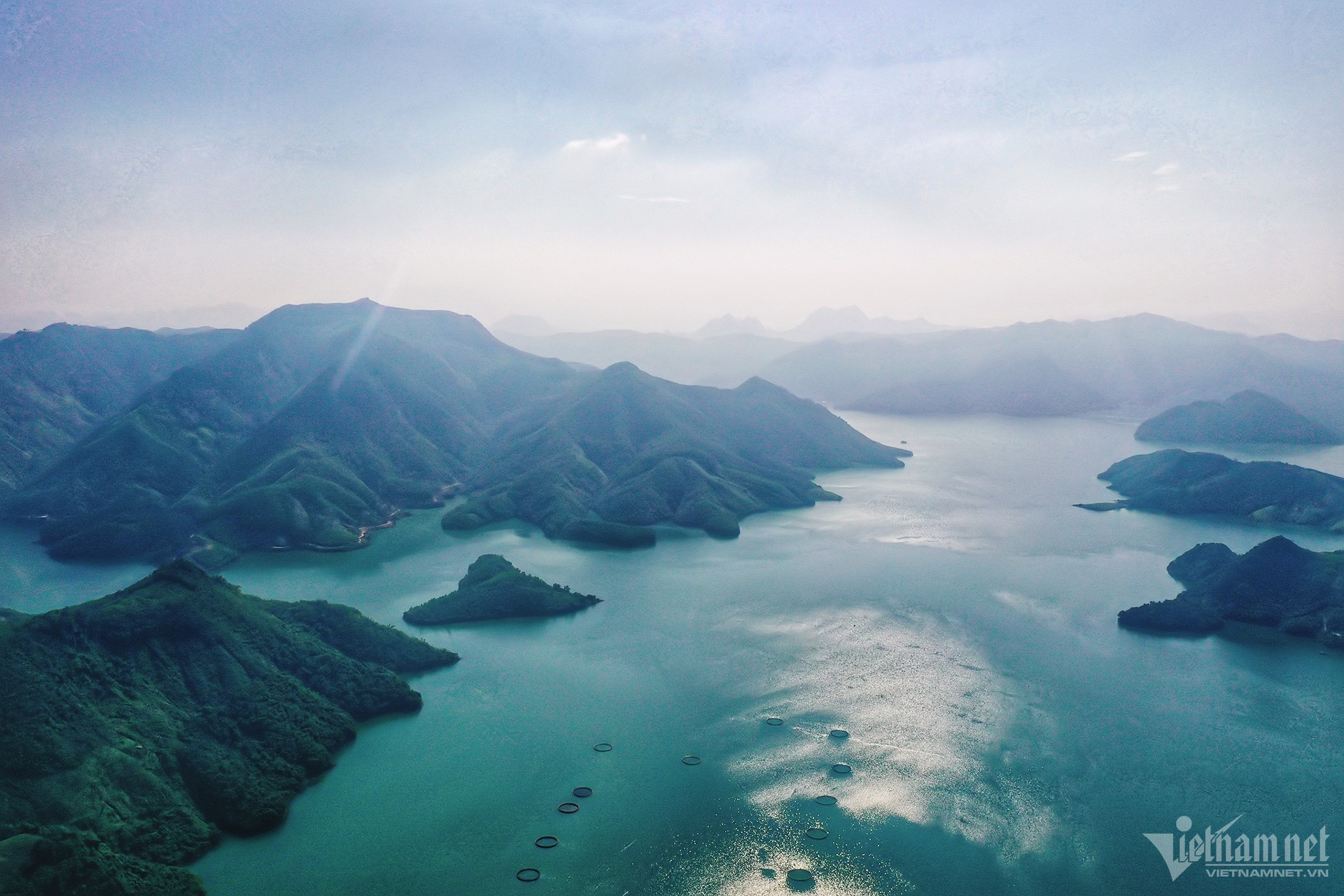
Hoa Binh Lake is the largest artificial lake in Southeast Asia, about 70km long, spreading over 17 communes in 5 districts and cities of the province. The lake bed area has 47 large and small islands with an area of nearly 160 hectares, of which there are 11 limestone islands with an area of 116 hectares and 36 mountainous islands with an area of nearly 160 hectares. In addition to the charming and poetic natural scenery, around this area, there is also a unique culture of the Muong, Tay, Dao and Thai ethnic groups.

Hoa Binh Lake has the advantage of having a total water surface area of over 8,800ha, deep lake bottom, rich aquatic resources of varieties and species, in addition to plankton, around the lake there are thousands of hectares of vegetation and vegetation. protection forest, with high coverage.
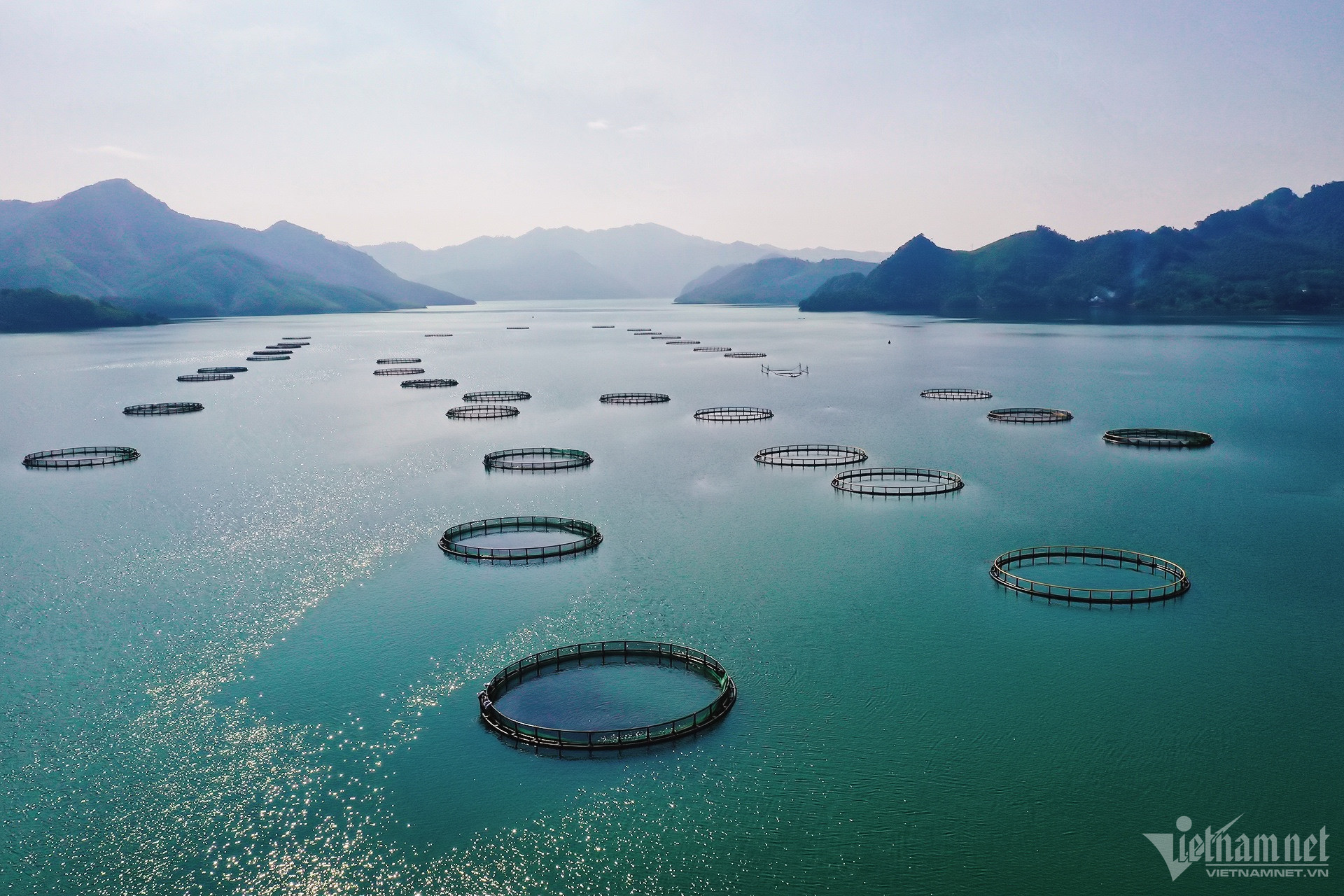
Also from here cage fish farming was formed, the life of more than 2,000 households along the lake became more and more full and full. In which, many families have boldly invested in raising 4-6 fish cages, bringing in an income of about 100 million VND/year.
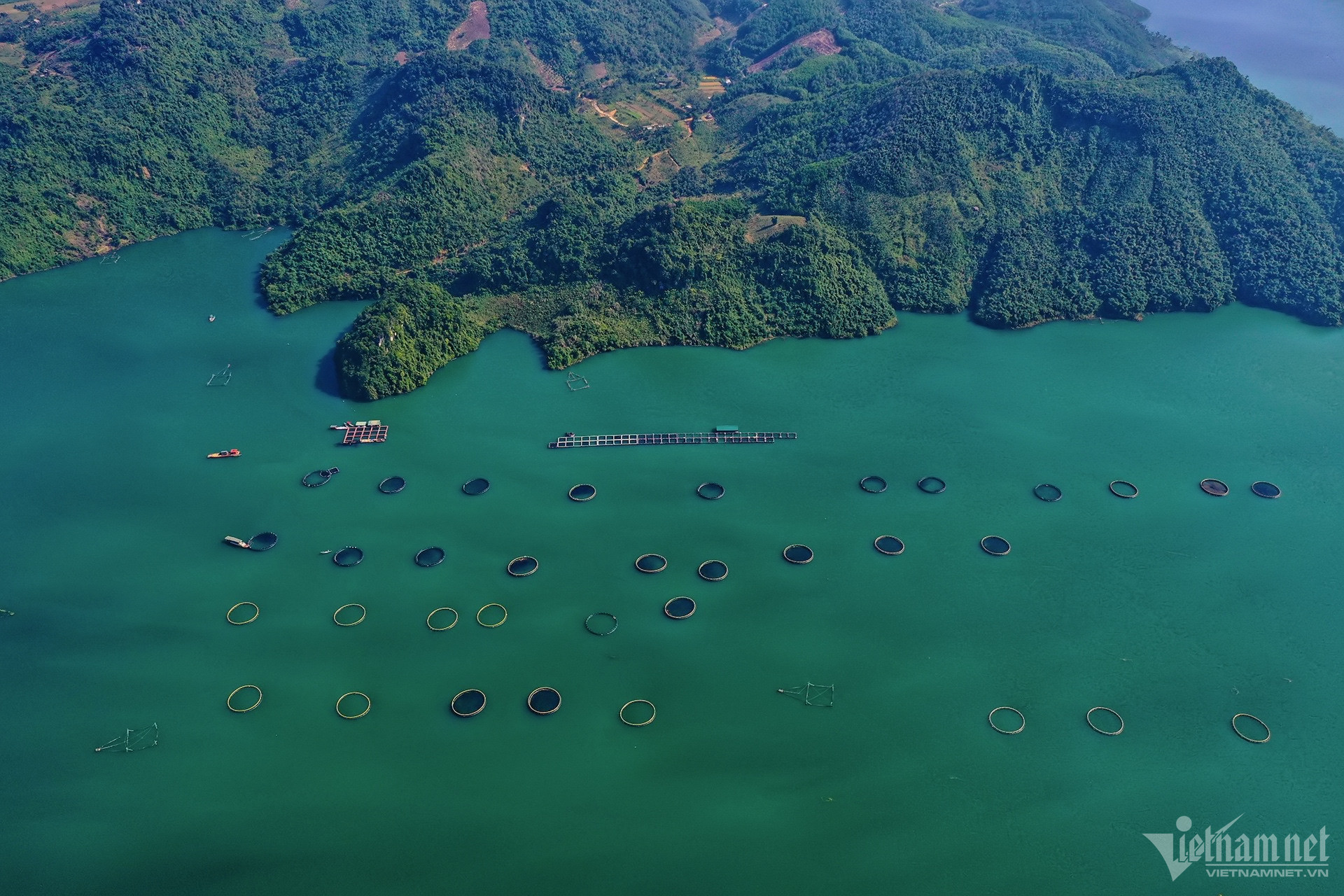
Da Bac district with an area of 96.6ha is one of Hoa Binh's localities to develop stable cage fish farming with more than 2,200 fish cages, concentrated in Hien Luong, Vay Nua, Tien Phong and Dong Ruong communes.
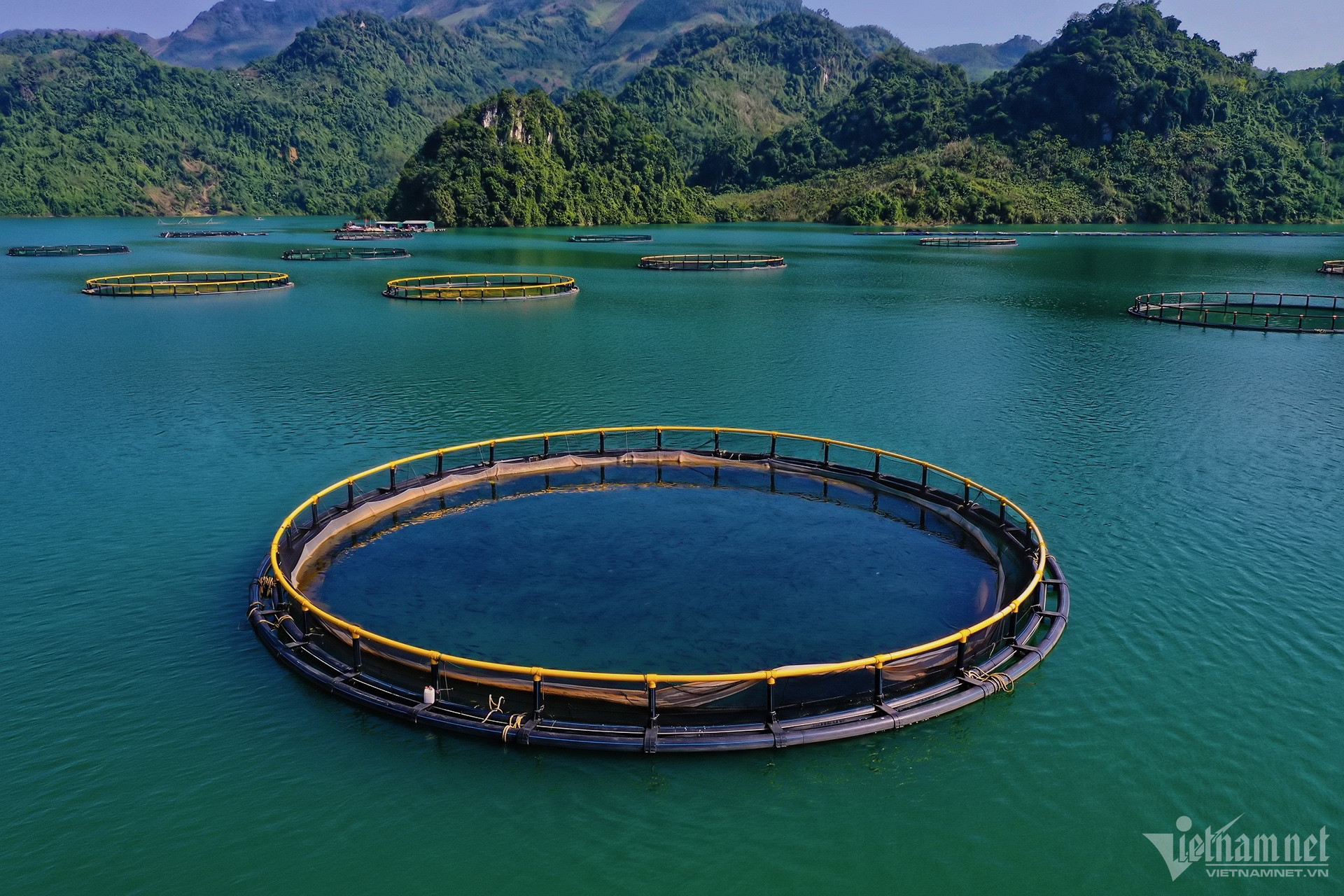
The province has about 2,000 households maintaining cage fish farming. There are households owning dozens of fish cages, concentrated in Mai Chau, Da Bac, Cao Phong, and Hoa Binh districts.
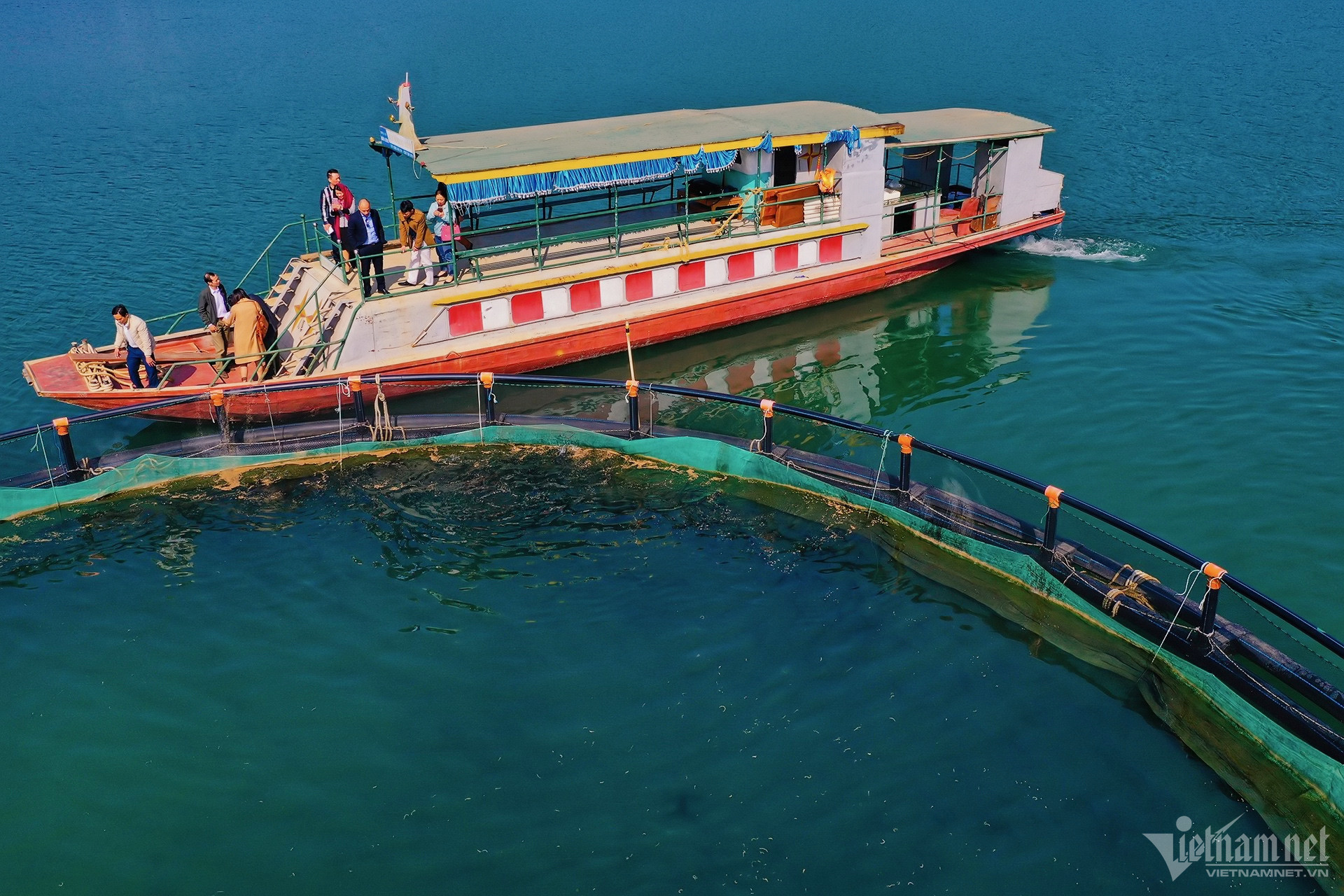
The selling price of all kinds of fish is quite stable, of which black carp is sold in cages from 150,000 to 180,000 VND/kg, sold in chains over 200,000 VND/kg; Pangasius ranges from 110,000 - 150,000 VND/kg. With such a price, even though the price of feed increases, fish farmers still make a profit.
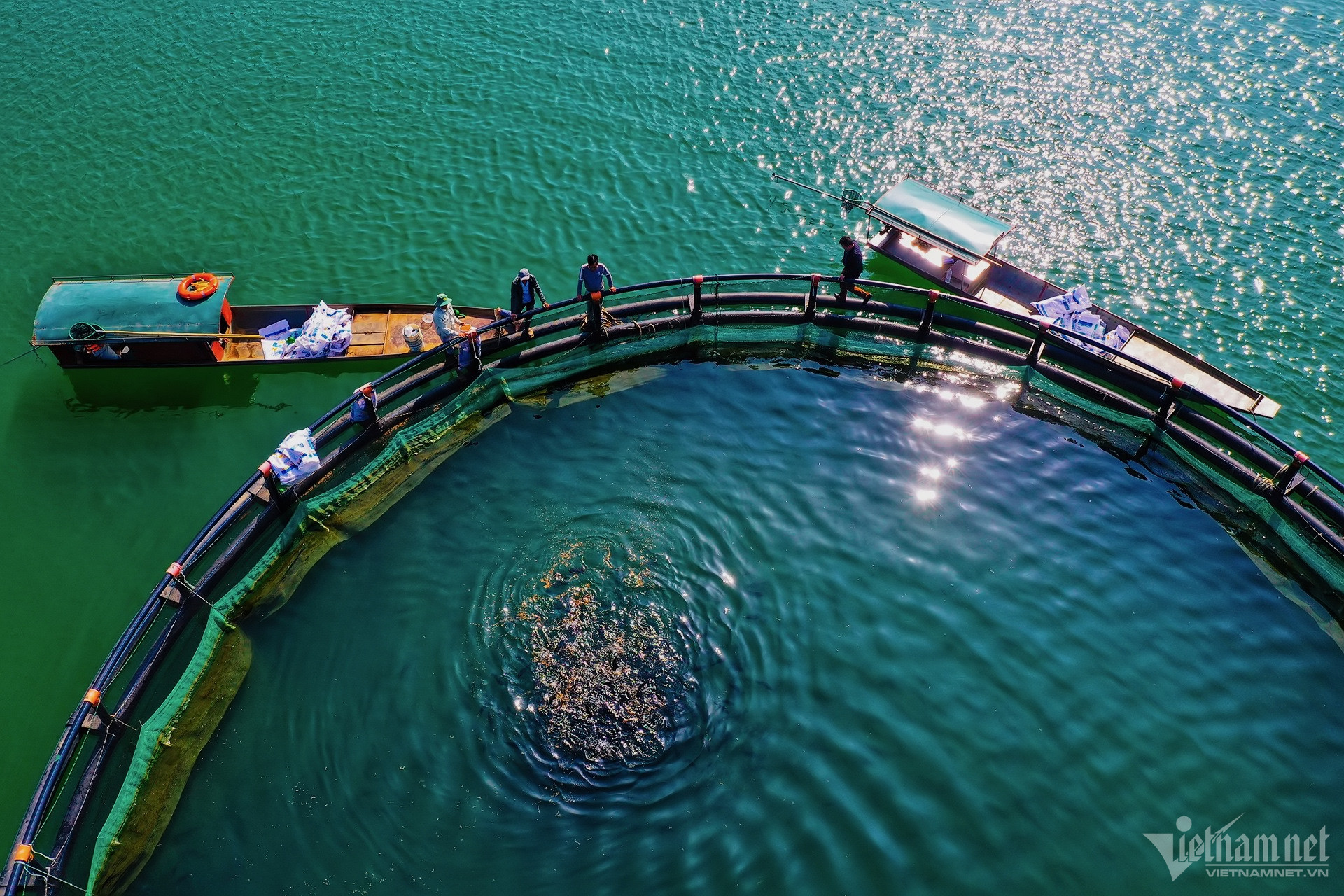
The selling price of all kinds of fish is quite stable, of which black carp is sold in cages from 150,000 to 180,000 VND/kg, sold in chains over 200,000 VND/kg; Pangasius ranges from 110,000 - 150,000 VND/kg. With such a price, even though the price of feed increases, fish farmers still make a profit.
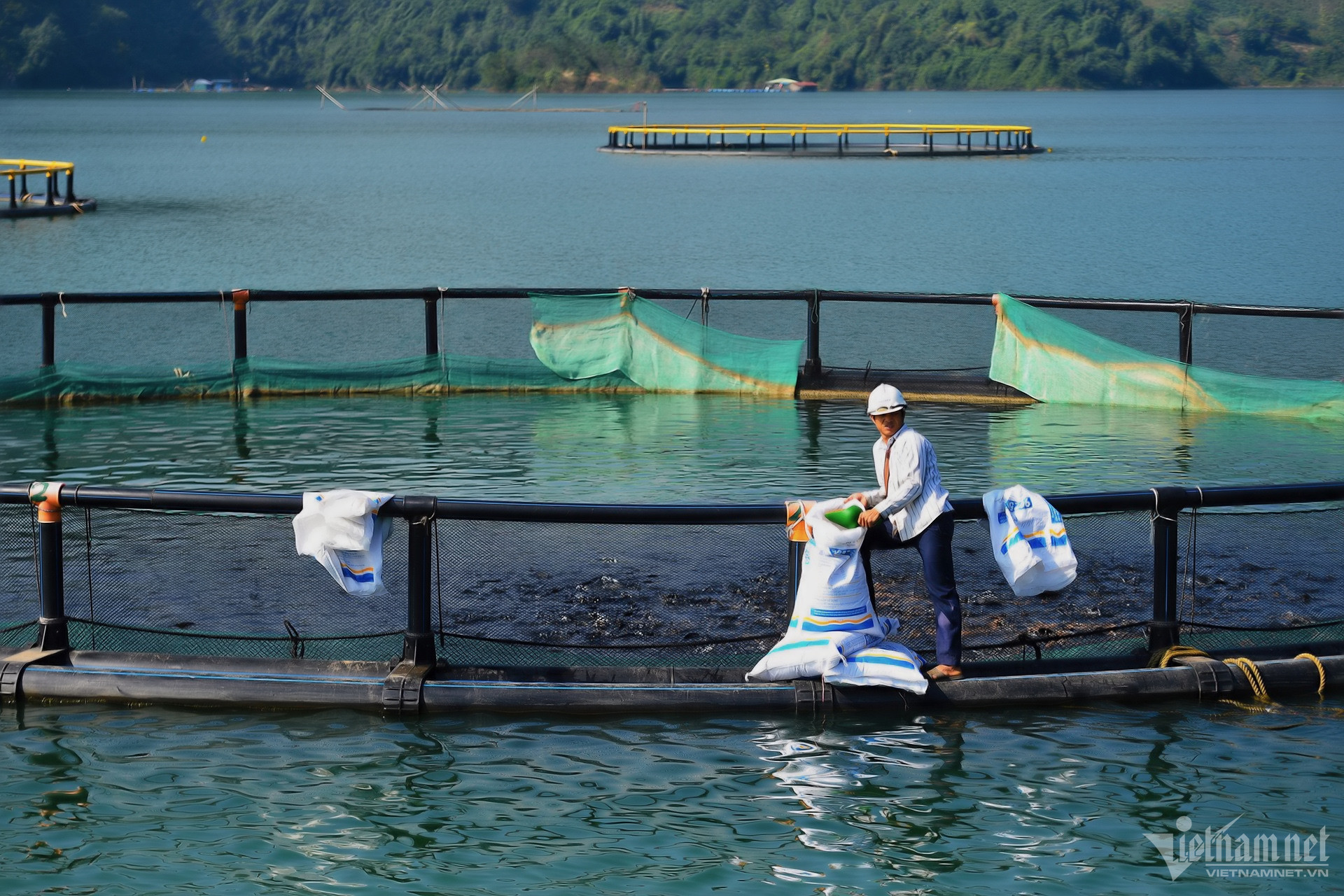
The main varieties of fish cultured on Hoa Binh lakebed include: American catfish, fried, lentil, dieu persimmon, carp, black carp, wild fish, sturgeon, grass carp, tilapia, white bird, and hybrid catfish.
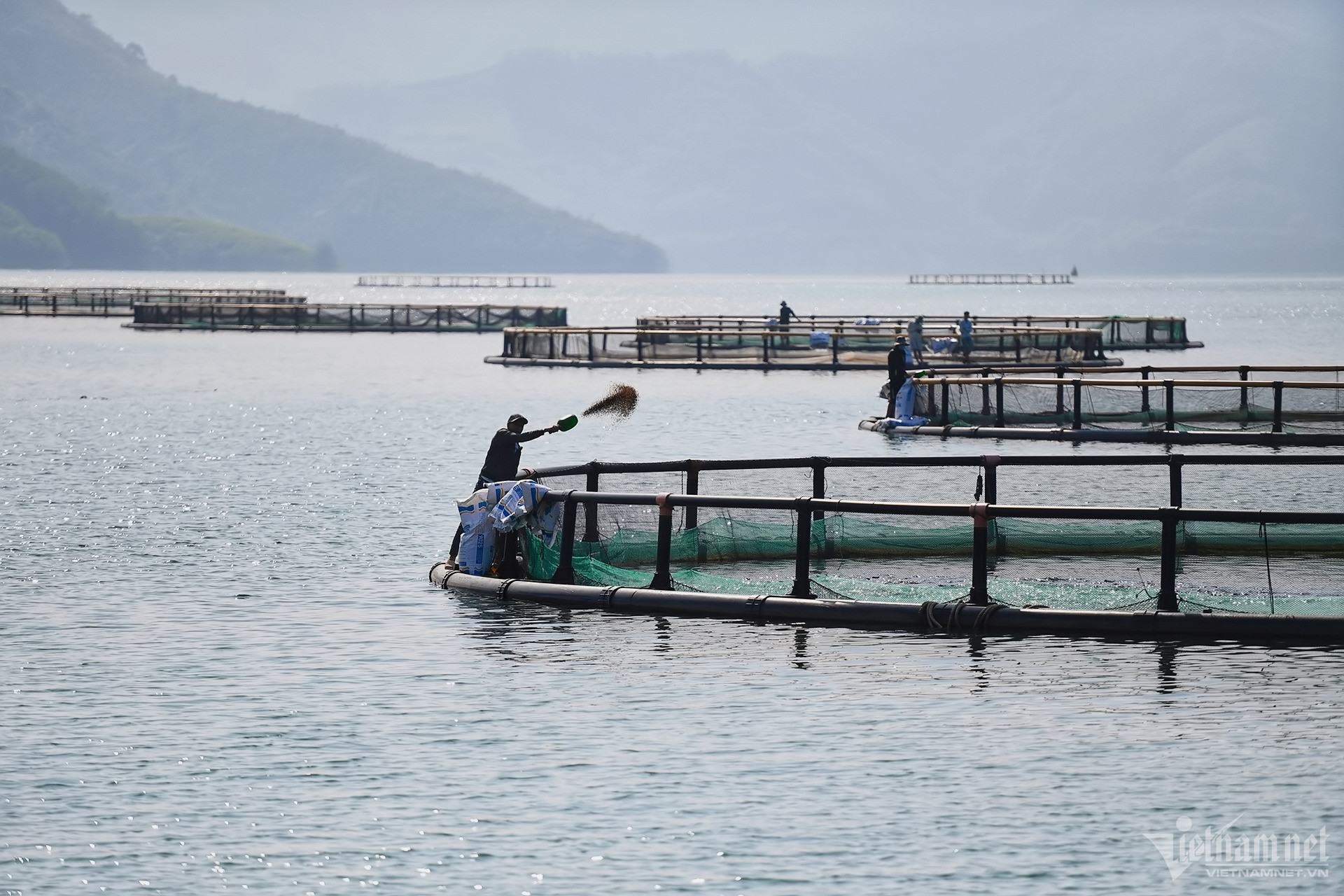
From a small initial farming scale, many aquaculture establishments have invested quite a lot to build farms, upgrade cages with large nets to supply thousands of tons of commercial fish to the market. school.
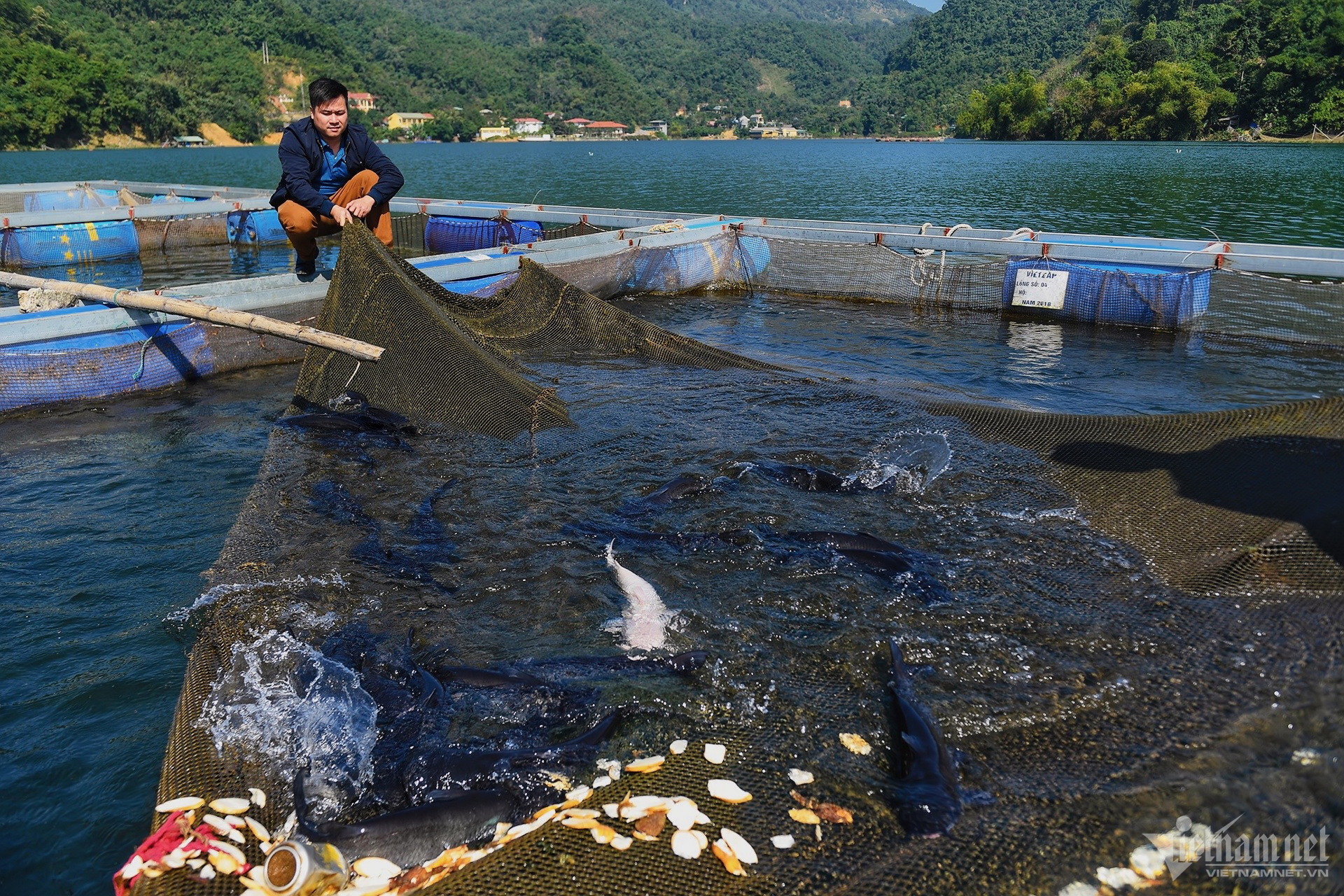
Currently, the whole province of Hoa Binh has more than 36 enterprises, cooperatives and cooperative groups in households investing in intensive fish farming with a scale of 4,750 cages, with an output of 6,150 tons/year.
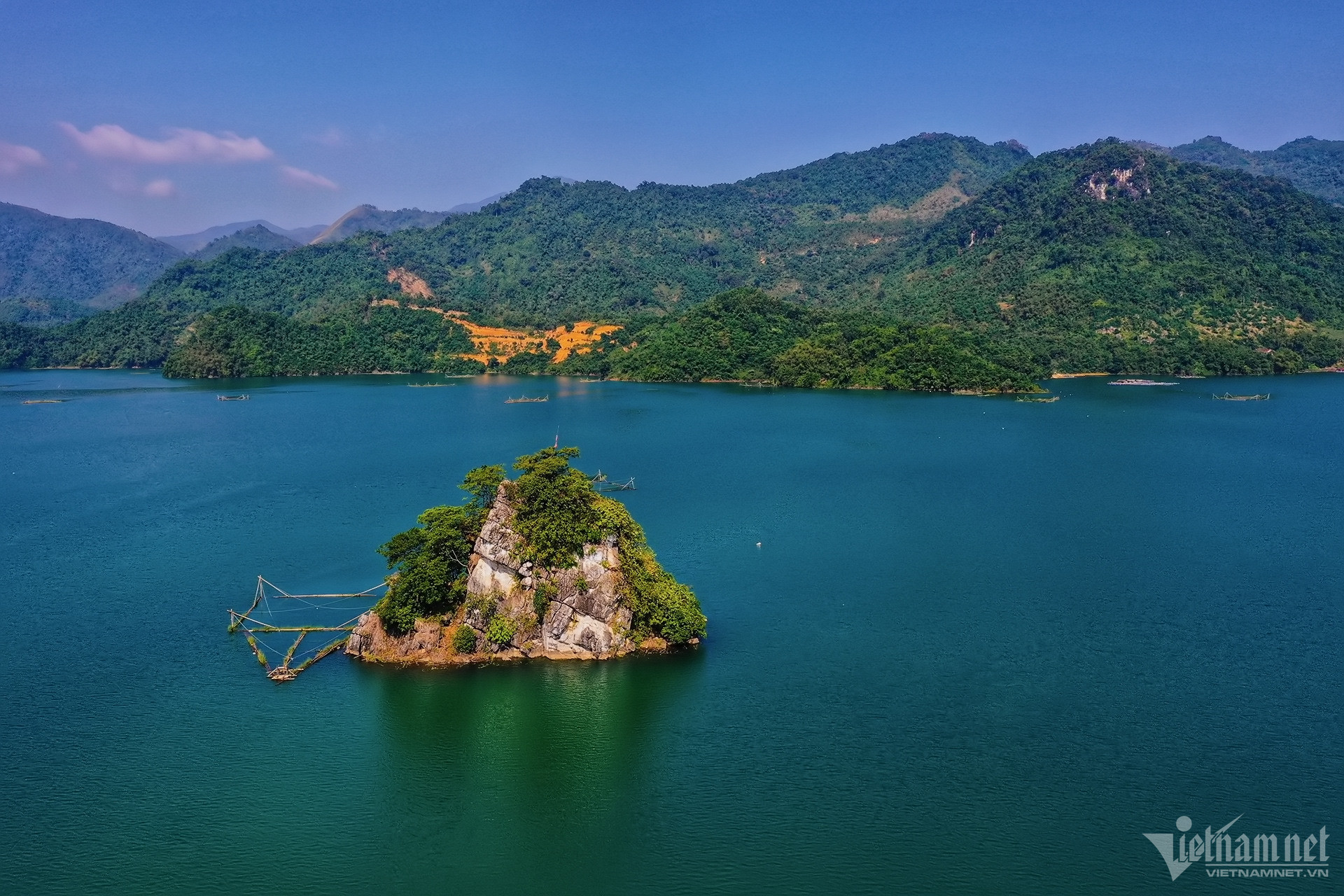
Hoa Binh Lake possesses charming, poetic landscape, unspoiled natural space, and is a resource, identified by this province as a key tourism development.
Hoa Binh 2271 view
Update day : 04/07/2023
Lung Van is located at the highest peak of Muong Bi. That's why this place is known as "the roof of Muong". Isolated by traffic, perhaps that is why Lung Van retains its pristine beauty from ancient times. Visitors coming here not only have the opportunity to admire the nature of the mountains and forests, but also enjoy the fresh, pleasant space, helping you feel extremely relaxed and comfortable. The road to explore Lung Van, although difficult, always creates a strange attraction for any traveler. Perhaps because of the clouds of sky hovering around the traveler, mixed with the natural scenery of mountains and forests. All create a beautiful, unreal picture. In particular, visitors can go to the highest position in Lung Van to admire the clouds flying in the early morning, when the sun has not yet risen. In the morning in Lung Van, the wind is cool and the sunlight is gentle, white clouds hover around the mountain tops and villages... When the sun appears, its rays penetrate straight through the dense layers of clouds and spill into the valley. The morning dew drops on a winter day settle on the green leaves of the terraced fields like sparkling jade. The white of the clouds, the yellow of the sunlight and the green of thousands of trees blend into one. All create a wonderful poetic picture in the middle of a mountainous region that can only be found in Lung Van. Besides the "cloud hunting" experience, visitors also enjoy other discovery activities such as climbing Co Tien mountain, trekking U Bo hill, enjoying the feeling of bathing in Mo stream or immersing yourself in fresh nature. Not only that, tourists also have the opportunity to participate in community cultural activities, or even experience the daily work of Muong people such as rice planting, rice harvesting, and fruit harvesting. This is also an opportunity to gain a deeper understanding of the cultural identity and life of the region here. Lung Van is known as the ideal "Rattan Hunting" spot. So which season of the year is best to travel to Lung Van? This is the question of many tourists. Lung Van is known as the "roof of Muong" and is most beautiful from after Tet to April every year because this is the time with the most clouds. The clouds drifted slowly from evening until the next morning. And it's not until noon that you see the clouds completely clear. Moreover, this is also the time when Muong people begin the planting season across the long terraced fields. So according to the experience of many backpackers, traveling to Lung Van Hoa Binh in April is the best time for cloud hunting. Or if you don't need to hunt clouds, choose the golden rice season in Lung Van in August, it will definitely not disappoint you.
Hoa Binh 2104 view
From January to December
Nine waterfalls Tu Son includes 9 waterfalls, each waterfall possesses its own unique beauty, both unique and blending together to create a beautiful landscape that makes many people ecstatic and fascinated. These include Au Co love waterfall, Tien Tam waterfall, Trai Chieu Quan Lang waterfall, Ut Lot waterfall, Silver waterfall, Truong Phu waterfall, Thuong Ngan month, Mau waterfall and Thien Ngoc Thach waterfall. Nine waterfalls are located in Kim Boi nature reserve, Cu hamlet, Tu Son commune, Kim Boi district, Hoa Binh province and about 60 km from the center of Hanoi capital. Therefore, this is an ideal rendezvous for people in Hanoi and neighboring provinces to have the opportunity to leave the hustle and bustle of the city and wander to pristine nature on short holidays or weekends. . Walking on the trail around those waterfalls, you will feel like you are going on an exciting trekking trip in a primeval forest with a poetic space and fresh, airy atmosphere. Somewhere you will also see a few wildflowers blooming, a few small squirrels on the rows of green trees. You will also listen to the roaring sound of the waterfall and the chirping of birds. The beautiful scenery will make you more excited, and the long journey will no longer be tiring. Continuing your journey to explore different waterfalls one by one, you will encounter enchanting waterfalls, containing the magical beauty of nature. These waterfalls have beautified the wild space, making it more poetic, sparkling, and charming. That scene not only makes you more excited and eager to explore nature, but also connects you and nature, making you even more connected and familiar. In the early mornings, the scenery around the waterfalls becomes dim and magical, making travelers from far away admire it in amazement. When the sun comes out to give bright yellow rays of sunlight, the water color of the waterfalls has a slight yellow tint, then at sunset it changes to a shimmering pink color. Perhaps the most beautiful time the waterfall is when a colorful rainbow spans across the "silver silk ribbons", illuminating the entire sky. Au Co Waterfall is located in the upper reaches of Tu Son peak at an altitude of about 1300 m above sea level. With this waterfall, travelers from far away will feel like they are admiring a shimmering silver silk strip in the middle of the ocean, like the long, silky hair of a young girl. Tiny sparkling water sprays illuminate a corner of the forest and vague, dreamy images flicker behind the waterfalls. Au Co Love Waterfall flows into Lac Long Quan Lake, next to it there is a giant round stone block, associated with the legend of the eternal love story between Au Co and Lac Long Quan and their 100 children, sharing the forest and the sea. If you have the opportunity to set foot in the royal garden at an altitude of more than 1,000 m in the nine waterfalls of Tu Son, visitors will also have the opportunity to freely admire the charming natural picture, letting their soul be blown away by the wind. At that time, you will surely feel fresh, gentle emotions and feel peaceful even in the middle of the wild mountains and forests. Visitors can also stop, enter small huts to rest, enjoy lunch and take a relaxing nap for a few minutes to get ready for the next journey of discovery. Just like that, it won't be too difficult for you to conquer these 9 beautiful waterfalls of Muong country!
Hoa Binh 1900 view
From January to December
Hoa Binh Hydropower Plant was built at Hoa Binh Lake, Hoa Binh province, on the Da River in Northern Vietnam. Before Son La hydroelectric plant was inaugurated, this was the largest hydroelectric plant in Vietnam and Southeast Asia. Hoa Binh Hydropower Plant - a century project built with help from the Soviet Union in 1979 in Hoa Binh City. Where Soviet experts and tens of thousands of engineers and workers, many of whom were teachers and students from the Faculty of Civil Engineering - Water Resources University, had unforgettable years, with determination and thirst. A burning desire to create miracles in conquering the Da River. On the largest scale construction site in Southeast Asia at that time, at peak there were up to 40,000 workers working. Although there are still many difficulties, lack of electricity, lack of water, hard and dangerous work, the enthusiasm of working youth has urged the hands and minds of engineers and workers to turn the river into a source of doll. Everyone did not care about difficulties and hardships, enthusiastically working up to 3 shifts, 4 shifts, all night long "for the tomorrow's electricity of the Fatherland". Labor slogans have now become legendary such as "High altitude". 81 or die" has shown the spirit of working urgently, enthusiastically, and overcoming difficulties of the young generation on the construction site. People's efforts and efforts to overcome all time and all dangerous terrain have been rewarded. On December 31, 1988, the first generating unit of Hoa Binh Hydropower Plant generated electricity to the system, signaling a historic moment for the country and the Vietnamese Electricity industry. On April 4, 1994, the eighth and last power unit of the plant was officially completed, with a total installed capacity of 1,920 MW. On December 24, 1994, our country excitedly celebrated the important event of the inauguration of the Hoa Binh Hydropower Plant on the Da River, marking the result of 15 years of selfless labor for the electricity of tomorrow for the Fatherland. Tens of thousands of officials, employees and experts on the construction site were constructing for the first time a great project of the twentieth century. After more than 30 years of operation, by 2021, the plant has provided the country with a total output of over 250 billion kWh, annually contributing more than 1,000 billion VND to the province's State budget. In addition, TDHB actively and effectively participates in flood control, ensuring safety for the Northern Delta and Hanoi Capital. With a large reservoir capacity of up to 10 billion cubic meters of water, the flood prevention capacity Flood estimated at 5.6 billion cubic meters, Hoa Binh hydropower plant has made a great contribution to flood prevention, ensuring safety for the entire Northern Delta region, especially Hanoi capital. Since the Hoa Binh Hydropower Plant was put into operation until now, the Northern Delta region has no longer had flooding. TDHB has controlled dozens of major floods of over 10,000 m3/sec; Typically, the historic flood in August 1996 had a flow of more than 22,650 m3/sec; The late flood that appeared in October 2017 (when the reservoir was full) had a flow of nearly 16,000 m3/sec with very complicated and unpredictable developments. At the same time, maintain the safety of the project and the downstream area of the Northern Delta.
Hoa Binh 1849 view
From January to December
Thung Nai in recent years has been a familiar destination every weekend for those who love peace, avoiding noise and dust. As a commune in Cao Phong district, Hoa Binh province, Thung Nai is located in the bed of Da river lake, 25 km from the city center and about 110 km from Hanoi. With the perfect combination of mountains, islands and clear blue lakes, Thung Nai brings poetic beauty and relaxing moments. Thung Nai in recent years has been a familiar destination every weekend for those who love peace, avoiding noise and dust. As a commune in Cao Phong district, Hoa Binh province, Thung Nai is located in the bed of Da river lake, 25 km from the city center and about 110 km from Hanoi. The name Thung Nai makes many people think of a valley with deer roaming around. According to local people, this place was once home to many species of wild deer. The poetic image of golden deer bewildered in the afternoon sunlight on the slopes, reflecting on the Da River, was used by people to name this land. Nowadays, coming to Thung Nai, although there are no longer wild deer, the poetic and romantic beauty of the mountains and rivers here seems to still be intact. To explore this "golden deer valley", you can only use a boat or walk. Leave the car on the shore, the motorboat will take tourists for a tour on the hydroelectric lake. In the strong wind blowing from the lake, the picturesque scene of Thung Nai appears before your eyes. A large lake surrounded by rolling mountains. In the lake, hundreds of large and small "islands" undulate like magnificent natural masterpieces. Floating on the water, the motorboat weaves through the rocky outcroppings, creating the feeling of enjoying "Ha Long on land". A perfect combination of rivers, lakes and mountain rocks, Thac Bo cave is a destination not to be missed when coming to Thung Nai. The cave is located deep inside the mountain and is quite wild, but the scenery inside is beautiful. The whole forest of stalactites grows up and down, with strange shapes. After the high water season, visitors entering the cave can enjoy schools of fish swimming freely in the shallow, clear water. Right near the cave is Ba Chua Thac Bo temple. Although the temple is quite small and located on a steep mountain slope, this place attracts many tourists from all over to worship. For many people, stopping at the temple is an opportunity to enjoy the beauty of Thung Nai from a high perspective with floating white clouds and glimpses of ethnic villages. An interesting thing here is that when the Da River water dries up, visitors to the temple have to climb up steep stone steps, sometimes stumbling. But during the high water season, the steps flood, visitors to the temple just need to step down from the boat. If you go on Sunday, don't forget to visit Thac Bo floating market. Not too noisy and crowded, but a very typical cultural feature of the Muong people in Thung Nai. Thung Nai in recent years has been a familiar destination every weekend for those who love peace, avoiding noise and dust. As a commune in Cao Phong district, Hoa Binh province, Thung Nai is located in the bed of Da river lake, 25 km from the city center and about 110 km from Hanoi. The name Thung Nai makes many people think of a valley with deer roaming around. According to local people, this place was once home to many species of wild deer. The poetic image of golden deer bewildered in the afternoon sunlight on the slopes, reflecting on the Da River, was used by people to name this land. Nowadays, coming to Thung Nai, although there are no longer wild deer, the poetic and romantic beauty of the mountains and rivers here seems to still be intact. To explore this "golden deer valley", you can only use a boat or walk. Leave the car on the shore, the motorboat will take tourists for a tour on the hydroelectric lake. In the strong wind blowing from the lake, the picturesque scene of Thung Nai appears before your eyes. A large lake surrounded by rolling mountains. In the lake, hundreds of large and small "islands" undulate like magnificent natural masterpieces. Floating on the water, the motorboat weaves through the rocky outcroppings, creating the feeling of enjoying "Ha Long on land". A perfect combination of rivers, lakes and mountain rocks, Thac Bo cave is a destination not to be missed when coming to Thung Nai. The cave is located deep inside the mountain and is quite wild, but the scenery inside is beautiful. The whole forest of stalactites grows up and down, with strange shapes. After the high water season, visitors entering the cave can enjoy schools of fish swimming freely in the shallow, clear water. Right near the cave is Ba Chua Thac Bo temple. Although the temple is quite small and located on a steep mountain slope, this place attracts many tourists from all over to worship. For many people, stopping at the temple is an opportunity to enjoy the beauty of Thung Nai from a high perspective with floating white clouds and glimpses of ethnic villages. An interesting thing here is that when the Da River water dries up, visitors to the temple have to climb up steep stone steps, sometimes stumbling. But during the high water season, the steps flood, visitors to the temple just need to step down from the boat. If you go on Sunday, don't forget to visit Thac Bo floating market. Not too noisy and crowded, but a very typical cultural feature of the Muong people in Thung Nai. As the boat slowly moves through the water, the windmill stands tall on the small island, attracting the attention of anyone passing by. This is like the invitation of a vacation home in the middle of the lake. Therefore, whether they come back during the day or stay overnight, most tourists coming to Thung Nai want to stop by this small island to see with their own eyes the seemingly unique windmill. in the Netherlands, or in the famous novel "Don Kihote - the talented nobleman of Manta". Not only is it unique, the windmill here also has a beautiful viewing spot. From here, you can zoom out into the distance, taking in the entire ink painting of Thung Nai in your sight. If you go up the "mill" early in the morning, you will see Thung Nai engulfed in mist, while when the sun rises, the clear blue lake surface sparkles yellow. In addition to the pristine natural landscape, the specialty parties of the Muong people have become a highlight in Thung Nai. It was a meal with stream fish, hill chicken and exotic wild vegetables.
Hoa Binh 1810 view
From January to December
Far from the hustle and bustle of the city, Mai Chau is famous for its pristine and peaceful natural scenery. Located in the heart of the Northwest mountains, this place is a beautiful picture of natural colors and unique cultural features of the nation. Mai Chau has winding trails through green forests, yellow terraced fields, or traditional wooden houses looming in the majestic space. Not only is it a beautiful natural land, Mai Chau is also a rich cultural museum of the Thai people. Here, traditional cultural features are still preserved and carefully cared for, from soft hand-painted fabric paintings to exquisitely carved wooden items. The oral art of the Thai people has been and is becoming the pride of the entire country of Vietnam. Mai Chau is a district in Hoa Binh province, about 150km northwest of Hanoi capital. With the wild natural beauty and unique culture of the indigenous people, this is an attractive destination for tourists who love to explore and experience the national cultural identity, as well as enjoy the atmosphere. The peaceful, quiet atmosphere of Vietnam's mountains. From October to February is one of the best times to travel to Mai Chau. This is the time when the air becomes chilly and peach and plum blossoms bloom. The magical scenery of white flower petals makes the land become poetic. Surely you will be attracted to the peaceful natural beauty of Mai Chau this season. Furthermore, if you are a lover of romantic spaces, or always want to immerse yourself in the chilly atmosphere, winter is a great time to come to Mai Chau and enjoy memorable moments. From March to April is also a good season to go to Mai Chau. At this time, ban flowers bloom throughout Mai Chau. Besides, the weather during this period is often cool and pleasant, very convenient for participating in outdoor activities such as trekking or enjoying the beautiful landscape of the Northwest region. If you want to experience the freshness and radiance of spring, along with the soothing scent of blooming banyan flowers, March and April are the ideal times to visit Mai Chau and enjoy the unique landscapes. of this season.
Hoa Binh 1912 view
From October to February
Possessing a spacious area of up to 350 hectares, Thang Thien Waterfall is part of the Vien Nam range, about 60km from the center of Hanoi. The road to Thang Thien Waterfall is quite easy, the route is short and the natural scenery is charming, so it is not surprising that this place quickly became a favorite sightseeing and picnic spot for many people. If you intend to go to Thang Thien Waterfall, you can go by bus or motorbike. If traveling by motorbike, don't forget to save the route MIA.vn revealed right below: Thang Long Avenue - Hoa Lac Hoa Binh Expressway - DT446 - Road 6 (AH13) - National Highway 6. From here, go A short distance further and you will reach the Ascension Waterfall. Many of you who have been here have shared that the most ideal time for you to start your journey to enjoy and explore Thang Thien Waterfall is between May and July. This is summer, the sky is clear, no rain. Suitable for you to participate in outdoor activities and picnics. Away from the bustling city, the journey back to Thang Thien Waterfall will soothe and comfort your soul. The scene at Thang Thien Waterfall is very beautiful with water rushing from above, creating white foam. Amidst the mist, the space at the waterfall seems more romantic. Thang Thien Waterfall is divided into many interesting levels, with each level covered by water creating a mysterious feeling. The higher you go, the road becomes quite slippery, so if you intend to reach the top, you should move slowly to ensure safety. Right below the foot of the waterfall is a lake full of cool water all year round. The water in the lake is clear and not too deep, so it is suitable for swimming. Surrounding the lake are rocks of all shapes and sizes, very suitable for those who want to have check-in photos during their Hoa Binh travel itinerary. Nestled deep in the heart of the jungle, the cuisine at Thang Thien Waterfall is mainly products of the highlands. After the journey to cool off and enjoy the scenery, you can recharge with a series of outstanding dishes, such as wild vegetables, bamboo-tube rice, buffalo meat cooked in bamboo leaves, spring rolls with grapefruit leaves, and grilled pork. , grilled fish, deep fried stream fish, etc.
Hoa Binh 2000 view
From January to December
Hoa Binh Prison is located on the True stream, on the left bank of the Da River, in Tan Thinh ward (Hoa Binh city). The prison was built in 1896 to detain common criminals. In 1943, the French colonialists transferred a number of political prisoners from Son La Prison to detention here. Hoa Binh Prison relic has an area of 1,500 square meters, was restored by the province many years ago and was ranked as a national relic in 2000. There are almost no remaining traces of the prison except a round guard tower. made of concrete, built by French soldiers on the Da Giang dike slope that still exists. According to historical records, Hoa Binh prison was originally built on a rectangular area of land, surrounded on the outside by 4 3-meter high walls, with barbed wire on the walls, 4 wall corners were 4 guard towers. In March 1943, the French colonialists transferred a number of political prisoners from Son La prison to Hoa Binh prison to reduce the number, while waiting for favorable conditions to transfer and relocate a number of prisoners. Detained in Con Dao. In the years 1943 and 1945, the activity movement of the Hoa Binh prison cell, led by comrade Le Duc Tho as Secretary, flourished and had a profound influence on the revolutionary movement in Hoa Binh province. In 1943, the prison cell had a plan to recruit new party members. This was the first class of party members the cell developed in Hoa Binh prison. In March 1945, seizing the opportunity of Japan's coup against France, under the direction of the Party Central Committee and the Northern Region Party Committee, the prison cell successfully launched and organized the struggle demanding the release of political prisoners. Within a week, the majority of political prisoners at the prison were released, and were actively helped by cadres and revolutionary masses of Hoa Binh town. Party cell members have returned to contact the Party Central Committee and the Northern Region Party Committee. A number of comrades were added to the province's revolutionary force... In August 1945, joining the offensive spirit of the whole country, the Muong people simultaneously shook off the mud and stood up brightly. The communist soldiers in Hoa Binh prison that day were also important factors contributing to creating momentum for the day the revolution rose. Hoa Binh Prison is evidence of a tool of repression, representing the crimes of the French colonialists, and is the place where revolutionary soldiers were detained and tortured. At the same time, this place has fostered and trained resilient and indomitable communist soldiers, keeping the revolutionary spirit and fighting for the independence and freedom of the nation. Every year, many visiting groups inside and outside the province come to learn about revolutionary traditions at Hoa Binh prison. The rebuilt Hoa Binh Prison relic not only contributes to illuminating history, but also shows the deep gratitude of the Party Committee, army and people of the province to the previous generations of ancestors; contributing to educating revolutionary traditions, helping each person become more deeply aware of the nation's history, thereby appreciating, preserving and promoting the value of the nation's history in the new era. Source: Hoa Binh Electronic Newspaper
Hoa Binh 2181 view
Muong Khoi War Zone is a revolutionary historical relic, a revolutionary base area during the general uprising to seize power in August 1945, belonging to the war zone system (Hoa - Ninh - Thanh) directly controlled by the Northern Party Committee. building and directing activities, here the Northern Party Committee opened a centralized military training class (Truong Son guerrilla anti-Japanese class). About 70km from Hoa Binh city center, about 15km from Vu Ban town, Lac Son district along road 12. Ranked as a national monument in 1993. Muong Khoi includes the land of 3 communes Hoai An, Hieu Nghia and Tan My (now An Nghia commune, Yen Nghiep commune and Tan My commune), located in the southeast of Lac Son district, with rugged mountainous terrain. Smoke has a very important strategic location, with road 12A running through it, connecting Ninh Binh province, Thanh Hoa province, connecting with road number 6, the gateway of the Northwest region. The operational area of the Muong Khoi war zone extends from Road 12A to the foot of the Truong Son mountain range, connecting with the war zones of Quynh Luu (Ninh Binh), Ngoc Trao (Thanh Hoa) and from Muong Khoi to Vu Ban town, Muong Vang (Cong Hoa - Lac Son region). Main relic sites of Muong Khoi revolutionary base: Area of three ancient banyan trees: Is the contact location to welcome officials of the Party committee of Hoa Binh province on revolutionary activities. On August 20, 1945, the armed forces and revolutionary masses of Muong Khoi gathered here to stand up to seize power in Lac Son province. This is where for the first time the red flag with yellow star of the revolutionary movement in Lac Son continent flew on top of the ancient banyan tree. Mr. Quach Hy's home area: Mr. Quach Hy and his son Quach Duong were the first national salvation members of Muong Khoi. Mr. Quach Hy's house is a place to welcome cadres, and is a contact point for Hoa Binh province's party committee and officials of the Northern Party Committee on activities to build revolutionary bases in the Muong Khoi war zone. Mr. Bui Van Khuynh's family area: Previously, his family resided in Lot hamlet, which was the location for organizing centralized revolutionary military classes of the Northern Party Committee (School of Guerrilla Anti-Japanese Learning). At the Muong Khoi war zone, the self-defense platoon for national salvation, the first armed force of the Lac Son revolutionary movement, was established here (March 1945). In July 1945, the Party Committee of Tonkin opened a centralized military training class (Truong Son guerilla anti-Japanese class) to train military officers to lead uprisings in localities in Tonkin. Muong Khoi War Zone was also the revolutionary area of comrades Bach Thanh Phong (standing member of the Northern Party Committee), Vuong Thua Vu (official of the Northern Party Committee), Le Quang Hoa (Secretary of the Party Committee). Party Committee of Son Tay province) and many core cadres of the revolutionary movement in Hoa Binh province and other provinces in Tonkin. Muong Khoi war zone is one of the cradles of the revolutionary movement in Hoa Binh province. During the uprising movement to seize power in August 1945, Muong Khoi was the place where revolutionary forces and the masses of Lac Son district conducted the first successful uprising to seize power in Hoa Binh province. Source: Hoa Binh province electronic information portal
Hoa Binh 2075 view
Trieu Phuc Lich monument at Tra slope, Toan Son commune, Da Bac district, Hoa Binh province. The monument was built in 1979, painted by artist Nang Mai. The monument is more than 3 meters high, located on the hillside to the right of the road to Da Bac town, and was recognized by the Ministry of Culture and Sports as a national historical relic in 1996. Perhaps the people of Toan Son commune do not know the captain Trieu Phuc Lich, who was always courageous and cunning in commanding the guerrilla team that fought to block many raids by the French invaders into his homeland. Especially the event of September 10, 1947 will forever be passed down to generations. That was when they received news that the French enemy at Che hamlet post (formerly Tu Ly commune) mobilized a platoon of over 20 legionnaires and soldiers to sweep the area of Toan Son commune. The commune's guerrilla team led by Trieu Phuc Lich, consisting of 30 people, quickly deployed an ambush plan to attack the enemy. The members' rudimentary weapons were crossbows, bows and arrows laced with poison, stone traps, bamboo poles, bamboo poles, rifles, and grenades stolen from the enemy. Near noon, the enemies arrived en masse. Waiting for them to fall into the ambush, Trieu Phuc Lich ordered an attack. The sound of gunshots, the sound of grenades exploding, a series of poisoned arrows flying at the enemy; Stone traps fell from halfway up the mountain onto the enemy's formation, causing them to panic and run away. In this battle, Toan Son commune's guerrilla team destroyed 14 enemies, captured 4 alive and captured 7 guns... History books write: Being attacked unexpectedly, advancing unsuccessfully, retreating was blocked, the enemy tried to flee along the trail through Sau stream to retreat to Tu Ly. Cleverly knowing the enemy's intentions, Trieu Phuc Lich sent guerrillas to pursue with the determination to completely destroy the enemy platoon. The captain himself chased after the enemy commander with his bare hands, then knocked the legionnaire down and quickly stole the submachine gun. Immediately after that, he discovered that the direction of the enemy's retreat was our base area. To ensure the secret of the base area and the safety of the guerrilla team's forces, Trieu Phuc Lich quickly distracted the enemy by running back to the rice fields. The enemy discovered him and immediately chased him and shot him, seriously injuring him. Even so, he still tried his best to pull out a dagger and stab the soldier standing nearby. Crazy about Trieu Phuc Lich's brave actions, the enemy soldiers discharged a magazine of bullets at him, the outstanding son of the Dao people of Toan Son commune heroically sacrificed his life. Trieu Phuc Lich's actions of robbing the enemy's guns with his bare hands, fighting tenaciously, and sacrificing heroically have ignited the patriotism and hatred of the enemy and encouraged the fighting spirit and victory over the French invaders of the Dao people in particular. and People of all ethnic groups in the province in general. Martyr Trieu Phuc Lich was posthumously awarded the first-class Resistance War Medal against the French. On June 11, 1999, Trieu Phuc Lich was posthumously awarded the title of Hero of the People's Armed Forces by the State. To commemorate the great contributions of him and the guerrilla team of Toan Son commune, and at the same time contribute to traditional education for future generations, the Provincial People's Committee directed the construction of the Victory Monument of Toan Son guerrilla team and it was inaugurated. September 2, 1991, on the 46th anniversary of National Day. The memorial was built on the exact spot where hero Trieu Phuc Lich fell in the past. His grave is located at the highest position on the Memorial grounds. Today, on holidays and New Year, officials, party members and people of Toan Son commune respectfully offer incense and flowers to commemorate the outstanding children and have more determination to join forces and unite to build a better homeland. renew. Source: Hoa Binh Electronic Newspaper
Hoa Binh 2023 view
Cao Phong - Thach Yen revolutionary base area belongs to Cao Phong district, Hoa Binh province. Because the activities of the base took place in the two communes Cao Phong - Thach Yen (old), the base was called Cao Phong - Thach Yen (now the relics belong to the communes Yen Lap - Yen Thuong - Cao Phong district). Ranked as a national monument in 1996. From mid-1944 onwards, after the Directive of the Party Central Committee on building guerrilla warfare bases in Hoa Binh province, especially after the Directive of the Standing Committee of the Party Central Committee (January 1945). ) on the construction of the Hoa - Ninh - Thanh war zone to proactively provide good areas for Vietnam's propaganda and liberation troops to advance through; At the same time as preparing militarily for the uprising to seize power, the revolutionary movement in Hoa Binh province developed quickly and strongly. The construction of the Viet Minh base progressed at a faster pace, until the end of 1944 and early 1945, in addition to Hoa Binh town, the Viet Minh base also spread to surrounding communes such as Quynh Lam and began to spread to Cao Phong region. Cao Phong - Thach Yen base area is located in a rugged mountainous area, although the base's operating area is very wide, including historical locations such as: 1. Khanh Pagoda Hill in Khanh hamlet, Yen Thuong commune. This is the training ground for the armed unit - the first team of officers of the base. After completing training here, the unit spread out to the hamlets to build self-defense teams. Comrades in this unit became squad leaders of self-defense teams of the hamlets. 2. Mr. Bui Van Y's family, Dai hamlet, Yen Thuong commune. It is a trusted base for comrades Vu Tho and Truong Dinh Dan... to travel and rest during the time participating in activities. His family contributed a lot of food and money to support the revolution. 3. Mr. Bui Van Hoanh's family lives in Trang hamlet, Tan Phong commune. It is a reliable base for comrades Vu Tho and Truong Dinh Dan... to go, return, eat, rest, during their time of operation at the Cao Phong - Thach Yen base area. 4. Trang village pagoda, Tan Phong commune. This is the location where the Party Committee of Hoa Binh province met in April 1945. During this meeting, the Staff decided to establish base areas. After the successful resistance war against the French, due to many reasons, the pagoda was damaged. 5. Mr. Pho Vien's family (aka Dang Chi Vien). He was instrumental in helping comrade Vu Tho to enlighten the tribes of the Cao Phong - Thach Yen region. During his time working at the base, his family became a trusted place for comrades participating in activities at the Cao Phong - Thach Yen revolutionary base. Mr. Pho Vien's family was also the location where the Provincial Party Committee convened the Provincial Conference of Representatives of the Viet Minh Front in July 1945 to implement the Directive of the Viet Minh General Headquarters on urgently preparing for an uprising to seize power. in Hoa Binh province. Cao Phong - Thach Yen war zone is one of the points to build the revolutionary base of the Party Committee of Hoa Binh province. The Cao Phong - Thach Yen base area is truly a solid base of the Hoa Binh province revolution and the Hoa - Ninh - Thanh war zone system, contributing a significant part to the overall victory of the Hoa Binh province revolutionary movement. . Source: Hoa Binh province electronic information portal
Hoa Binh 1989 view
The relic marking Cu Chinh Lan's victory in destroying tanks is currently located on Giang Mo slope next to Road 6A (old) in Giang Mo hamlet, Binh Thanh commune, Cao Phong district, Hoa Binh province. Heroic martyr Cu Chinh Lan (real name Cu Van Mau), was born in 1930 in a poor farmer family in Quynh Doi village, Quynh Luu district, Nghe An province. In 1946, the French army returned to invade our country. Cu Chinh Lan, then only 16 years old, applied to join the National Guard and volunteered to go fight the enemy. In November 1951, the French colonialists expanded their attack into our free zone in Hoa Binh with a plot to reconnect the "East - West corridor" to cut off our communication between Viet Bac and Areas 3 and 4. to regain the initiative on the main battlefield. In Hoa Binh, they carried out a plot to establish an "autonomous Muong Land" to sabotage national unity. On November 24, 1951, the General Military Commission decided to open the Hoa Binh campaign. In the battle on December 13, 1951, when the French army entered the battlefield, the whole unit opened fire fiercely, destroying an enemy company. When preparing to withdraw, enemy tanks came to reinforce and fired fiercely at the team. our formation, blocking the escape route and causing many soldiers casualties. Mr. Cu Chinh Lan quickly jumped on the tank, placed the submachine gun into the gap in the turret and pulled the trigger, but unfortunately the submachine gun choked, the tank was still running and shooting. He shouted to his teammates to gather grenades for him, then continued to jump into the car, pull the lid and throw the grenade into the car. The enemy picked up the grenade and threw it back and drove the tank to change direction. The opportunity to destroy the enemy tank was right before his eyes, Mr. Cu Chinh Lan boldly opened the grenade latch, waited for the smoke to escape for a few seconds before throwing it into the cockpit. The grenade exploded, the enemy soldiers in the car died on top of each other. The tank branded "B2885498 USA", stopped on the spot, the battle ended successfully. The resounding victory at Giang Mo slope with the heroic spirit of Hero Cu Chinh Lan and the soldiers of Battalion 353, The 66th Regiment destroyed the tanks of the French invaders equipped by the US imperialists, starting the movement to defeat the enemy's modern battle tanks with conventional weapons. On December 29, 1951, when participating in a fierce battle on Route 6, Luong Son - Hoa Binh section. Even though he was seriously injured, Cu Chinh Lan still did not leave the battlefield, commanding the squad to continuously break open layers of barbed wire fences into the enemy bunker, clearing the way for his teammates to destroy the enemy. When the enemy's Co To post was completely destroyed by our troops, that was also the time he breathed his last. He died when he was just 21 years old. On May 19, 1952, at the first National Congress of Emulation Soldiers, martyr Cu Chinh Lan was one of the first 7 people nationwide to be posthumously awarded the title of Hero of the People's Armed Forces by the President. people . To remember the victory of Hero Cu Chinh Lan, in 1993, the Ministry of Culture and Information issued a decision to recognize the location marking Cu Chinh Lan's victory in destroying French tanks as a national revolutionary historical relic. . In 1994, construction began on the relic site, erecting the Tank Destroyer Hero Monument. Source: Hoa Binh Electronic Newspaper
Hoa Binh 1978 view
Trung Bao Temple and Temple, formerly known as Beo Temple (named after the village because behind the village there is a mountain range called Tiger Mountain). The relic is located in Trung Bao village, Thanh Cao commune, Luong Son district, Hoa Binh province. The temple consists of two architectural items: Trung Bao Temple and Trung Bao Temple. Trung Bao temple and shrine were recognized as national historical-cultural relics in 1997. - Trung Bao Temple: Worshiping three gods is the Three Great Kings Tan Vien Son Thanh; National Mother Hoang Ba and Tutelary God of Trung Bao village. Located on a spacious area of land next to the edge of the village, is a spacious and majestic temple. On both sides of the temple are the village's bamboo piles that provide shade, in front of the temple are rice fields, and behind is the Dragon stream flowing through. The temple has a rectangular structure, the temple face faces Northeast, consists of three compartments, the roof is covered with Huong Canh tiles, and the two gables are built with bricks. In front of the temple, there is a great pagoda embossed with three Chinese characters: Thuong Hieu Than (supreme god). - Trung Bao Temple: Worshiping the Three Great Kings Tan Vien Son Thanh; National Mother Hoang Ba and Village Tutelary God. The temple was built on a high ground in the northwest of the village, about 300m from the temple. The landscape here is quite beautiful. In the eyes of feng shui experts, the Temple is located on the land of Turtle's shell (the Metal Turtle God appears). Behind the temple are the Hufu and Longling mountains. The remaining three sides have a winding stream with tall tall trees providing shade. The ancient temple was made of wood and thatched, with three compartments and a domed roof (tortoise shell shape). Over time, the tropical monsoon climate with lots of rain and sunshine, combined with historical changes, the temple with wooden architecture and thatched roof did not last long. During the reign of King Khai Dinh the 2nd (1917), the commune's people contributed efforts and funds to rebuild the temple, with a rectangular-shaped architecture, in front of which there was a great letter with 4 embossed Chinese characters. : Bao Son Duc Tu (Treasure Mountain that molds goodness). Currently, Trung Bao Temple still retains three original decrees conferred by the dynasties of the Feudal State of Vietnam on the gods worshiped at the temple. - Trung Bao temple and shrine festival is held annually once a year on the 11th and 12th day of the 11th lunar month every year. During the festival, folk games take place such as cockfighting, shuttlecock throwing, swinging... Trung Bao temple and shrine festival is closely associated with cultural identity, showing scenes of fun and celebration of villagers after a good harvest. Through the festival, we will understand the traditional rituals of the people at the border of the "Viet - Muong" cultural area in Hoa Binh. At the same time, we also understand the desires, aspirations and identities of the people here through the rituals and ceremonies of the festival. Source: Hoa Binh province electronic information portal
Hoa Binh 1798 view